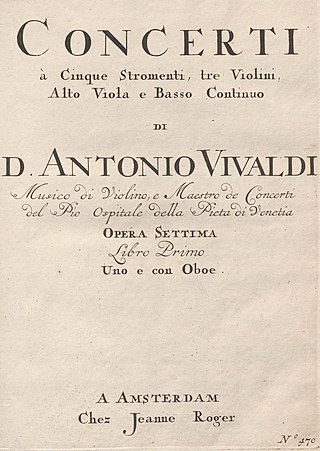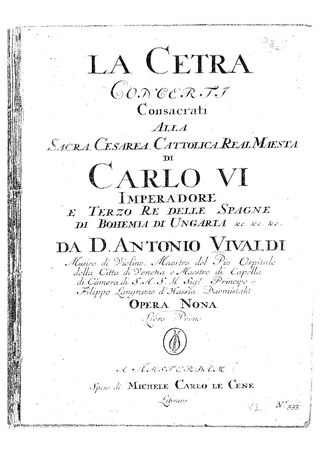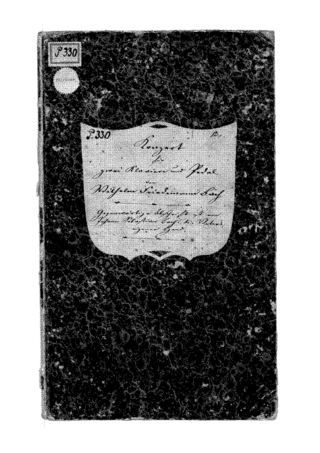The year 1730 in music involved some significant events.
The year 1718 in music involved some significant events.
The year 1717 in music involved some significant events.
The year 1716 in music involved some significant events.
A major is a major scale based on A, with the pitches A, B, C♯, D, E, F♯, and G♯. Its key signature has three sharps. Its relative minor is F-sharp minor and its parallel minor is A minor. The key of A major is the only key where the Neapolitan sixth chord on (i.e. the flattened supertonic) requires both a flat and a natural accidental.
F major is a major scale based on F, with the pitches F, G, A, B♭, C, D, and E. Its key signature has one flat. Its relative minor is D minor and its parallel minor is F minor.
G minor is a minor scale based on G, consisting of the pitches G, A, B♭, C, D, E♭, and F. Its key signature has two flats. Its relative major is B-flat major and its parallel major is G major.
A minor is a minor scale based on A, with the pitches A, B, C, D, E, F, and G. Its key signature has no flats and no sharps. Its relative major is C major and its parallel major is A major.

L'estro armonico, Op. 3, is a set of 12 concertos for string instruments by Italian composer Antonio Vivaldi, first published in Amsterdam in 1711. Vivaldi's Twelve Trio Sonatas, Op. 1, and Twelve Violin Sonatas, Op. 2, only contained sonatas, thus L'estro armonico was his first collection of concertos appearing in print. It was also the first time he chose a foreign publisher, Estienne Roger, instead of an Italian. Each concerto was printed in eight parts: four violins, two violas, cello and continuo. The continuo part was printed as a figured bass for violone and harpsichord.

A set of twelve concertos was published by Estienne Roger in 1716-1717 under Antonio Vivaldi's name, as his Opus 7. They were in two volumes, each containing concertos numbered 1-6. Of the set, ten were for violin solo; the other two were for oboe solo. The authenticity of some of the works included has long been doubted by scholars. Three are now considered spurious for stylistic reasons. They are: No. 1 in B-flat major for oboe, RV Anh. 143 ; No. 7 in B-flat major for oboe, RV Anh. 142 ; and No. 9 in B-flat major for violin, RV Anh. 153.

La stravaganza [literally 'Extravagance'], Op. 4, is a set of concertos written by Antonio Vivaldi in 1712–1713. The set was first published in 1716 in Amsterdam and was dedicated to Venetian nobleman Vettor Delfino, who had been a violin student of Vivaldi's. All of the concertos are scored for solo violin, strings, and basso continuo; however, some movements require extra soloists.

Il Cimento dell′ Armonia e dell′ Inventione is a set of twelve concertos written by Antonio Vivaldi and published in 1725 as Op. 8. All are for violin solo, strings and basso continuo. The first four, which date back to 1718–23, are called The Four Seasons. The set was published in the Amsterdam workshop of Michel-Charles Le Cène and dedicated to Wenceslas, Count of Morzin, an advisor to Charles VI, Holy Roman Emperor.

La cetra, Op. 9, is a set of twelve violin concertos by Antonio Vivaldi, published in 1727. All of them are for violin solo, strings, and basso continuo, except No. 9 in B flat, which features two solo violins. The set was named after the cetra, a lyre-like instrument, and was dedicated to Emperor Charles VI.

Twelve Trio Sonatas, Op. 1 is the first collection of musics composed by Antonio Vivaldi, and published by the Venetian publisher Giuseppe Sala in 1705, the first edition is believed to have been published around 1703. These sonatas are for two violins and basso continuo. The last music is a same title of "La Follia" as Corelli's Twelve Violin Sonatas, Op. 5.

Antonio Vivaldi composed several sonatas for cello and continuo. A set of six cello sonatas, written between 1720 and 1730, was published in Paris in 1740. He wrote at least four other cello sonatas, with two manuscripts kept in Naples, another in Wiesentheid, and one known to be lost.

Hooked on Classics 2: Can't Stop the Classics is an album by Louis Clark and the Royal Philharmonic Orchestra, published in 1982 by K-tel, part of the Hooked on Classics series.
The concerto transcriptions of Johann Sebastian Bach date from his second period at the court in Weimar (1708–1717). Bach transcribed for organ and harpsichord a number of Italian and Italianate concertos, mainly by Antonio Vivaldi, but with others by Alessandro Marcello, Benedetto Marcello, Georg Philipp Telemann and the musically talented Prince Johann Ernst of Saxe-Weimar. It is thought that most of the transcriptions were probably made in 1713–1714. Their publication by C.F. Peters in the 1850s and by Breitkopf & Härtel in the 1890s played a decisive role in the Vivaldi revival of the twentieth century.

The organ concertos of Johann Sebastian Bach are solo works for organ, transcribed and reworked from instrumental concertos originally composed by Antonio Vivaldi and the musically talented Prince Johann Ernst of Saxe-Weimar. While there is no doubt about the authenticity of BWV 592–596, the sixth concerto BWV 597 is now probably considered to be spurious. Composed during Bach's second period at the court in Weimar (1708–1717), the concertos can be dated more precisely to 1713–1714.

Mi-Young Park is a Korean-American violinist.










